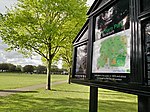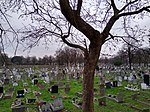St Katherine's Church, Plaistow
1891 establishments in England1965 disestablishments in England19th-century Church of England church buildingsChurch of England church buildings in PlaistowFormer Church of England church buildings ... and 1 more
Former churches in London
St Katherine's Church, Plaistow was a Church of England church on Chapman Road in Plaistow, Newham. It opened in 1891 as a mission church of St Mary's Church, Plaistow, using a building that had earlier been used to house the infant department of that church's day schools. In 1894 a permanent church was completed. In 1965 it was demolished for redevelopment.
Excerpt from the Wikipedia article St Katherine's Church, Plaistow (License: CC BY-SA 3.0, Authors).St Katherine's Church, Plaistow
Brook's Road, London Plaistow (London Borough of Newham)
Geographical coordinates (GPS) Address Nearby Places Show on map
Geographical coordinates (GPS)
| Latitude | Longitude |
|---|---|
| N 51.5339 ° | E 0.02019 ° |
Address
Brook's Road
E13 0NG London, Plaistow (London Borough of Newham)
England, United Kingdom
Open on Google Maps







